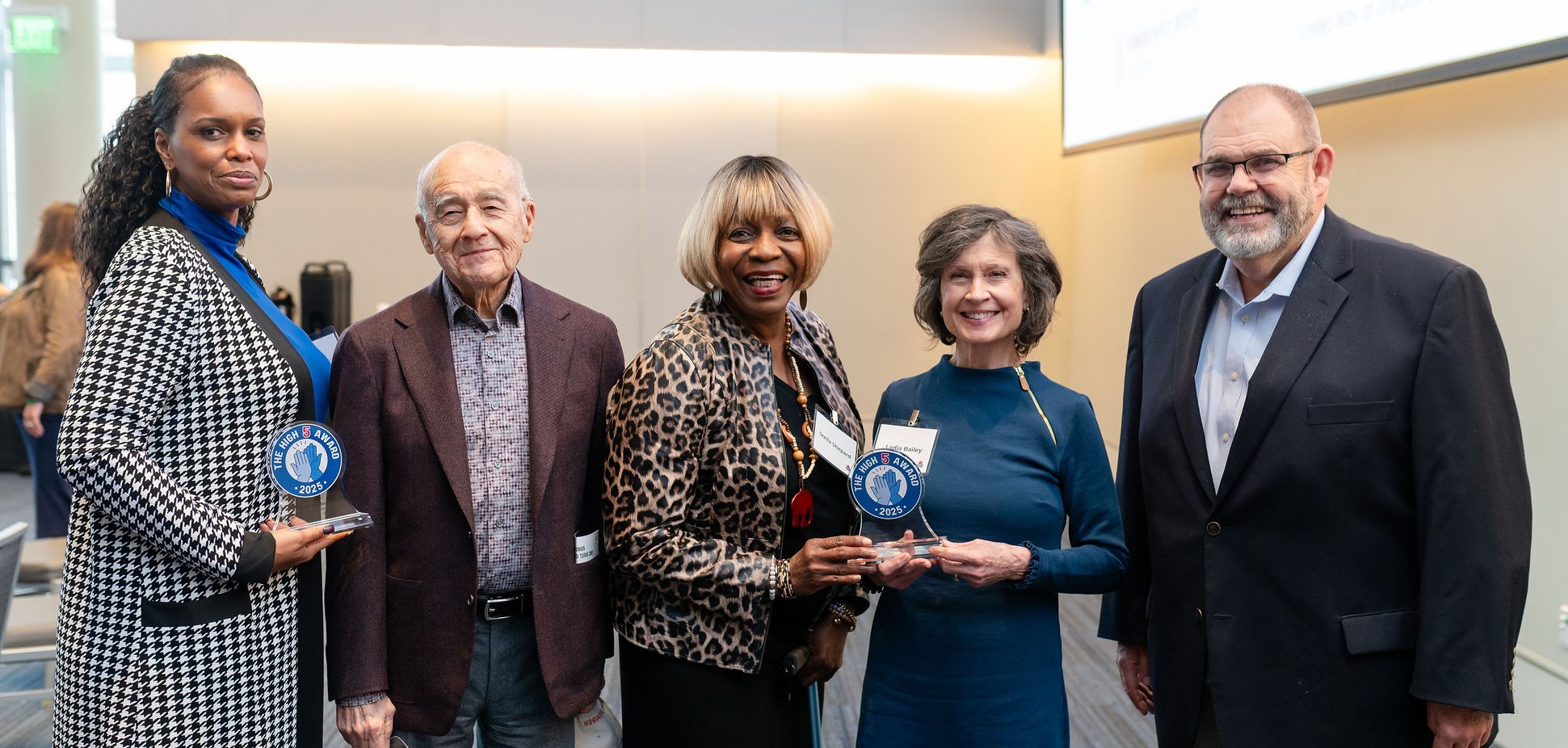By: Sarah Hudacek, Policy Assistant, Advocates for Ohio's Future
Hope A. Lane Gavin, Health Equity Fellow, The Center for Community Solutions
Throughout the COVID-19 pandemic, a myriad of temporary health and human service programming was created to help stabilize families facing unprecedented illness, job loss and closures. Much of this programming was targeted at low-income working families with children including enhanced unemployment benefits, the Pandemic-EBT program, increased and advanced Child Tax Credit, the Special Supplemental Nutrition Program for Women, Infants and Children (WIC) benefit boost, SNAP access to college students and more. While these programs were undoubtedly impactful to those who could access them, (the Child Tax Credit temporarily slashed child poverty, for example) there was little help for non-working older adults without children under 18 in the home.
As part of temporary COVID-19 programming, all Ohio households receiving SNAP have been receiving temporary emergency allotments.
As part of temporary COVID-19 programming, all Ohio households receiving SNAP have been receiving temporary emergency allotments to bring their monthly benefit to the maximum amount for their household size. When the federal Public Health Emergency (PHE) ends, all beneficiaries will return to receiving their base benefit. While this loss in federal food assistance will undeniably hurt everyone who relies on the program to meet their nutritional needs, older adults, a population that already disproportionately struggles with food security, will face the most severe impacts.
In April 2022, as part of Advocates for Ohio’s Future (AOF) ongoing Public Health Emergency Unwind Work, AOF collaborated with The Center for Community Solutions and The Ohio Association of Foodbanks to conduct interviews with Ohioans age 60 and older currently participating in the Supplemental Nutrition Assistance Program (SNAP).
Pre-pandemic look at senior hunger
While much of our time was spent on the current state of individuals’ food security, (while receiving emergency allotments), there were many challenges prior to the pandemic in accessing and affording food:
- All interviewees reported that their base SNAP benefit did not cover their monthly food and nutrition needs
- All interviewees reported regularly relying on family, friends or foodbanks to meet their food needs
- Nearly all interviewees reported they’d regularly skip meals or ration food
- All interviewees described calculated shopping techniques to stretch their benefit longer; including purchasing cheaper, less healthy food, canned goods, discounted foods, and forgoing protein and fresh fruits and vegetables
- Nearly all interviewees reported forgoing medical essentials or going into medical debt because their discretionary income was being used to supplement their SNAP benefits
Nearly all interviewees reported they’d regularly skip meals or ration food.
Older adult households see greatest benefit and have the most to lose when temporary benefits end



Increased SNAP benefits and increased quality of life
Because older adults are expected to lose as much or more in SNAP benefits when temporary pandemic program expansions end, we interviewed 10 older adults across the state currently receiving SNAP to talk benefit adequacy and hear what these emergency benefits have meant to them.
Here are some of their stories:
We spoke with a 60-year-old single woman in Cuyahoga County who relies on a fixed Social Security Disability and pension payment due to being unable to work because of a fibromyalgia diagnosis in addition to being a cancer survivor. Throughout the pandemic, she had been receiving an additional $95 in SNAP benefits, which she will lose at the end of the PHE. Prior to receiving temporary enhanced SNAP benefits, she would purchase food items her doctor advised against because of their higher sugar preservative content, such as canned vegetables, to stretch her $150 benefit throughout the month.
Throughout the pandemic, however, she has no longer needed to wash canned foods before eating them, as she has been able to purchase more expensive fresh and frozen vegetables with her extra benefits. She already participates in extreme couponing groups on social media and will have to rely on coupon sharing and food pantries like May Dugan’s Seniors on the Move to supplement her food needs at the end of the PHE. She noted that her doctor put her on a particular diet to manage more of her health complications without medication. However, food pantries don’t normally have the bulk of the food her doctor recommends.
When asked: “Is there anything you wish elected officials understood about how you get enough wholesome food?” she answered:
Seniors have limited income and need other medical things or certain diets, medications, diabetic shoes, etc. not just even food. All these programs to help the elderly [are ending], they built the country and now at the end of their lives that they’re supposed to be enjoying they’re getting the short end of the stick. We need better food quality. Some states prescribe healthy food, like WIC for the elderly. When are we going to get that for Ohio?
We spoke with a 61-year-old single woman in Meigs County who has Type 2 Diabetes, high cholesterol, osteoarthritis, Stage 1 emphysema, and Stage 3 Chronic Obstructive Pulmonary Disease (COPD). She tries not to go to food banks to save resources for those in worse situations than she is, plus the nearest food bank is about 30 miles away. Prior to the pandemic, she was receiving just $19 a month in benefits and was never able to get enough food to feel healthy and productive. She described in great detail that she was often unable to function mentally and physically as her brain “didn’t work” when she was hungry. During this time, she never bought meat or fresh food because she couldn’t afford it and primarily only purchased things on sale. Sometimes she would buy marked down “mystery” cans without a label on them.
Prior to the pandemic, she was receiving just $19 a month in benefits.
With her extra benefits, she is able to buy unbleached bread that is better for her diabetes. Fresh fruits and vegetables, however, remain a challenge because of inflated prices and lack of access to variety due to Meigs rural geography. Because she’s spent less of her budget on food costs, she described finally being able to buy a new pair of tennis shoes with diabetic insoles, which aren’t covered by insurance. She can also have a cup of coffee whenever she wants. Her family gave her groceries for her most recent birthday.
When asked “How has inflation (higher costs for food) impacted your food budget and your other household expenses?” she answered:
I try to get a small thing of milk and make it last for as long as I can. I don’t have fresh fruits and vegetables in the house all the time but I try to get some when I can. Try to buy a little extra bread to freeze. Try and buy the cheapest mayo and ketchup, etc. I know the exact prices of the absolute cheapest condiments at Walmart. I really just try to buy as cheap as I can. Knowing that the cheap stuff isn’t going to be the best for you… but I have to buy whatever I can find. If I can eat two meals a day and try to have enough food for the whole month, that’s good.
We spoke with an 84-year-old single woman in Summit County who relies on an $841 monthly Social Security Retirement benefit to meet all of her needs. Prior to receiving SNAP emergency allotments, she relied on savvy shopping techniques (visiting multiple stores in one trip for the best deals, coupons etc.) to stretch her benefits but still have enough food to eat her vegetarian diet. Having additional food assistance has allowed her to prepay her funeral expenses so she and her family no longer have to worry about being burdened with an unexpected expense when the time comes.
She describes avoiding food pantries if she can help it due to the food not being as healthy as she would like, as she tries her best to avoid white breads and canned goods. She shared with us that although she lives in what she describes as “exurbs,” transportation to and from food sources is a tremendous challenge, not only for her but others in her community.
When asked “With your increased pandemic SNAP benefit, are you able to get enough food to feel healthy and productive?" She answered:
It makes it easier because I don’t have to worry about running around to each store to get the least expensive food. It’s helped my anxiety because I don’t have to run to a number of stores to save money, I can shop where I prefer because I have more in SNAP benefits.
We spoke with a 63-year-old man from Athens County who will lose $500 in SNAP benefits and who supports his wife, his son, and two grandkids. Before the pandemic, his wife was diagnosed with diabetes, which he attributes to not being able to purchase enough healthy foods with their SNAP benefits. Prior to receiving enhanced benefits, his household purchased mostly nonperishable and canned foods, and would use coupons and sales to try to stretch their benefits further.
With enhanced benefits during the pandemic, his family has rarely had to ration food like they did before. After benefits return to pre-pandemic levels, he is worried about coping with medical bills from his wife’s worsening diabetes and affording enough food.
When asked: “Is there anything you wish elected officials understood about how you get enough wholesome food?” he answered:
I think it is terrible news that the extra money is going away. I think the elected officials should do more to take care of their citizens. Not everyone in Athens can afford healthy food. Extra SNAP benefits has had a positive influence to my financial capacity and gives me food courage. My family can confidently have our three daily meals.
We spoke with a 62-year-old single woman with diabetes and hypothyroidism from Jackson County who will lose $230 in SNAP benefits at the end of the pandemic, and who received only $16 per month in SNAP prior to emergency allotments. Prior to the pandemic, she would visit foodbanks, shop sales, and use online coupons to stretch her SNAP benefits, but still shared that there were times she didn’t pay bills because she needed food or medicine. Based on her doctor’s advice, she also needs protein shakes to stay healthy, which she has to pay for out of pocket because they aren’t covered by insurance. She would sometimes eat only soup and crackers for days to make sure she could afford her medications.
With enhanced benefits, her pantry, freezer and fridge are stocked for the first time. She called the extra help a godsend. She’s been able to eat better and has lost weight during the pandemic. Because SNAP benefits freed up money for bills, she has paid down her medical debt and was able to purchase new clothes. At the end of the pandemic, she’ll go back to visiting her foodbank, purchasing lower quality food, and searching for coupons online to get by.
When asked “In what ways did having increased SNAP benefits have an impact on your health?” she answered:
I am not as hungry. Better quality food is more satisfying. My mental health has improved significantly. I am not as stressed out about getting the food I need. I don’t have to pick and choose as much. I can get quality meat. I have been able to be healthier and have even lost weight.
We spoke with a 63-year-old single woman from Cuyahoga County with a Master’s Degree and with diabetes who relies on Social Security Disability Income to get by. With extra SNAP benefits, she has been able to eat fresh fruits and vegetables, instead of the canned foods she ate before the pandemic. She used to have to sacrifice healthy foods, like apples, to have enough money left to afford staples like toilet paper, which is not covered by SNAP.
She has worked consistently since she was 14 years old until she became disabled and lost her job. Her overall health is better because she’s no longer stressing about how she’s going to get food. She shared that it’s not just a caloric issue, it’s about having better mental health, too. Before the pandemic, she had to rely on family and friends to help supplement her monthly grocery budget, and she expects to begin relying on them again when enhanced benefits end. She will also turn to the foodbanks and churches to make up for the deficit in SNAP benefits.
When asked: “Is there anything you wish elected officials understood about how you get enough wholesome food?” she answered:
Elected officials, unless they grew up close to poverty, they have no idea what being on SNAP means. When I was growing up, you walk to the fridge, there’s always stuff in it. There are times now when that’s not the case. Elected officials don’t know what it’s like to go to the fridge or cabinet and not have things like butter. I want to be able to buy milk, almonds, walnuts, the good coffee. Real food is expensive. Fresh fruits, vegetables are expensive. People don’t get that. The scammers are what make the news. You don’t see me trying to eat bread crumbs to survive. An extra $50 would change my world. $50 would change my reality. If [the government] can do it now [during the pandemic], why can’t they keep doing it?
Increased SNAP benefits: impact is the same regardless of age, race, geography

To participate in our interview project, respondents had to meet three simple criteria: live in Ohio, be 60 years of age or older and currently participate in the SNAP program. Although our interviewees came from a diverse cross section of age (ranging from 60-84 years old), race, gender, geography, household composition and more, their stories, when boiled down, are vastly similar:
- All interviewees shared how the increased SNAP benefits had a positive impact on their health
- All interviewees shared that the increased SNAP benefits improved their food-purchasing power, improving the quality and quantity of their grocery trips
- All interviewees shared increased SNAP benefits freed up money for other essential bills and household expenses (ranging from prescriptions, appointments, and medical debt to toilet paper and utilities)
- All interviewees relied on at least one other public assistance program in addition to SNAP, such as Medicaid, Percentage of Income Payment Plan Plus (PIPP), Home Energy Assistance Program (HEAP), Social Security Disability Insurance (SSDI), or the Medicare Premium Assistance Program (MPAP).
Elderly Simplified Application Project
In the last state budget, the Ohio General Assembly recognized the increasing need to address food insecurity among older adults and thus approved of an Elderly Simplified Application Project (ESAP) waiver. Beginning on July 1, 2022, Ohio will join Alabama, Florida, South Carolina, and a number of other states that have implemented demonstration projects like ESAP to help increase administrative efficiencies and decrease barriers for older adults and disabled households without earned income in accessing SNAP benefits.
While administrative churn – or cycling off of SNAP because of missed paperwork (and not due to ineligibility) is a problem for many low-income households, it is exacerbated in households headed by older adults. The risk of churn, frequency, duration of churn spells and the value of foregone SNAP benefits vary based on household circumstance but all contribute to older adults experiencing gaps in SNAP benefit receipt. Churn entails costs for county agencies, too, having to spend time recertifying benefits for households whose circumstances generally stay the same by nature of having no earned income.
The ESAP waiver will extend the certification period for these households to 36 months.
The ESAP waiver will extend the certification period for these households to 36 months with the goal of improving customer experience and administrative efficiency and boosting SNAP participation among this population. While ESAP does not address benefit adequacy, for many households, getting connected to and staying enrolled in benefits is the first step.
What’s next?
For a multitude of reasons, including but not limited to food insecurity, social isolation and increased risk of infection, older adults were hit particularly hard by the economic and public health crisis caused by COVID-19.
As these stories make clear, none of the SNAP recipients interviewed are taking these temporary benefits for granted. Not only did these older adults consistently share that temporary benefits helped them feel more secure and confident in their ability to afford a full month of groceries, but these benefits also helped them save more of their income to pay off debt, purchase medical items not covered by insurance, and helped them improve their health.
None of the SNAP recipients interviewed are taking these temporary benefits for granted.
Older adults typically live on fixed incomes, meaning their income is stable from month to month, but also meaning that their budgets have little flexibility to absorb today’s rapidly rising prices and often food is the first part of their budget to be reduced.
We’re all aging. Ohio’s elected leaders cannot overlook the importance of supporting food benefits for older adults, which is essential to ensuring the health and well-being of all Ohioans. For now, the PHE is expected to be extended through October 15, 2022. The time to prepare for the loss of these benefits and the resulting food insecurity faced by millions of Ohioans is now.








